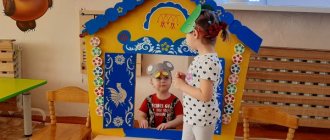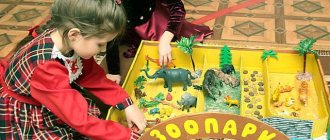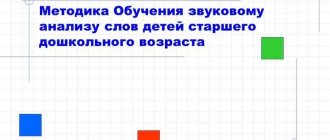Target. Improve phonetic perception, the ability to determine the number and sequence of words in a sentence. Continue working on the semantic side of the word.
Progress of the lesson
“How many of you have seen crystal things that sparkle in the light of lamps? - the teacher begins the conversation. – These could be... glasses, shot glasses, salad bowls, candy bowls, sconces, chandeliers. Or maybe an autumn day can be crystal clear?
In the original autumn there is a short but wonderful time - The whole day is as if crystal, And the evenings are radiant.
These lines were written by the wonderful Russian poet Fyodor Tyutchev. What amazingly precise and beautiful words are found in this quatrain. Did you hear? Initial autumn – what kind of autumn is this? What word can replace the word marvelous?
The teacher explains what radiant evenings are. Then he asks the children to count the number of words with the sound r in the first two lines of the poem (repeats them) and name these words.
“Can you name the first two sounds in the word marvelous? Di is part of the word. There are other words starting with di-. Which? (Dima, Dina, Dinara, director, sofa...) Let's look in the dictionary and find words starting with di-. So: diet, diadem, savage, curiosity, porcupine, dynamo, disc, conductor. Are all the words familiar to you? And the tiara, the porcupine, the conductor? Determine in which part of the word the sound r is heard in the word conductor?
Next, the teacher invites the children to play the game “I am for you, you are for me” and reminds of its rules: “First I will say a sentence, and you will count the number of words in it and name them. Then one of you will say your sentence and I will count the number of words. So, how many words are in the sentence “The lingonberries are ripening, the days have become colder?”
Children count the words (4–5 answers), and then name the words in the order they appear in the sentence.
“Now let’s play differently,” says the teacher. - Dima, your word keeps up, Sasha’s word is lingonberry, Ira’s has become colder, Masha’s has become colder, Katya’s has colder days. Come to my table and decide who will stand with whom, and then say the proposal.”
If confusion occurs, the game is repeated with other participants. (The reception was offered by G. Belyakova.)
Next, one of the children pronounces a sentence and asks the teacher to count and name the words in it. The teacher is given the task by 1-2 more children.
At the end of the lesson, the teacher reads to the children F. Tyutchev’s poem “There is in the original autumn...” or K. Balmont’s “Autumn.”
* * *
In the original autumn there is a short but wonderful time - The whole day is as if it were crystal, And the evenings are radiant... Where the cheerful sickle walked and the ear fell, Now everything is empty - there is space everywhere, - Only the web of thin hair Glistens on the idle furrow. The air is empty, the birds are no longer heard, But the first winter storms are still far away - And clear and warm azure is pouring onto the resting field... F. Tyutchev
Autumn The lingonberries are ripening, the days have become colder, and the cry of birds makes my heart sadder. Flocks of birds fly away, beyond the blue sea. All the trees shine in a multi-colored dress. The sun laughs less often, There is no incense in the flowers. Soon autumn will wake up and cry awake. K. Balmont
Lesson 3. Sound culture of speech. Preparing for literacy
⇐ PreviousPage 4 of 18Next ⇒
Target. Improve children's auditory attention and perception. Learn to determine the number and order of words in a sentence.
Progress of the lesson
The teacher asks the children what kind of objects are in front of them and why they are needed in a lesson on speech development (cards from math sets, small objects, sheets of paper, pencils).
The teacher monitors the correct use of complex sentences by children.
Then he invites the children to clap their hands if they hear the sound ts
:
heron, crane, scratched, wounded, blossomed, withered, singer, dancer, ballerina, kiss
.[5]
The teacher takes note of children who make mistakes or respond to a word late, focusing on the response of their peers. Additional work needs to be done with these preschoolers later. But this can also be done in class, inviting only these children to complete a new task (explaining the reason): princess, too much, stubborn, girl, but written, beauty
.
The teacher asks the children to listen very carefully to the lines from G. Lagdzyn’s poem “Tell”, to count the words in the text with the growling sound p
and show a card with the appropriate number of geometric shapes (circles, triangles). The teacher reminds the children that they need to work independently.
Where are you going, magpie? Tell! Show us the way to the dense forest!
The teacher asks the children a riddle:
The golden apple rolls across the sky, smiling in the morning. And smiles are rays, very hot. (Sun)
The teacher asks preschoolers to determine how many words with the sound h are in the text of the riddle .
Then he reads the riddle again, pronouncing the words slowly and clearly, and the children count the words with the sound
h
.
The teacher asks the children to draw grids of three cell windows and determine the location of the sound h
in words:
cup, eyeglass case, hoop
.
Children, using chips or small objects, mark the position of the sound h
in words. (After completing each task, the child removes the chip(s).)
"The word cup
starts at
cha-
,” the teacher continues the lesson.
– How many sounds do you hear? Name these two sounds. Two sounds are already a syllable, that is, part of a word. Try to remember words that begin with the syllable cha-.
(Tea, kettle, watch, cups.) There are quite a lot of such words.”
The teacher opens the dictionary and reads words starting with the syllable cha-,
for example:
seagull, sorcerer, czardash, cha-cha-cha, ditty, palisade
. Interested in what czardash, cha-cha-cha, palisade is?
Then the teacher asks the children what a sentence is. (These are several words connected to each other.)
“The wonderful Russian poet Alexei Pleshcheev has a poem “Granddaughter”. It begins like this: “Grandma, you were little too...” Can you count the words in this sentence? Does it have four or five words? Let's count. Grandmother
- one,
you
- two... Now say the words in strict sequence one after another.”
The teacher points to the child. He says the word, and all the children say his number.
Child. Grandmother.
Children. Once. (One.)
Child. You.
Children. Two.
And so on.
If someone was in a hurry and missed a word, everything starts all over again.
The teacher tells the children that in books there is a period at the end of the sentence: “When you look at the books, pay attention to the periods. You will see that there are long and very long sentences, and there are short and very short sentences. If you find something interesting, share your observations with me.”
At the end of the lesson, the teacher asks the children what they learned today. (We learned to hear words, explain their meaning, and prepared for school.)
If you have time, you can read A. Pleshcheev’s poem “Granddaughter” to the children (this poem can also be read during a walk or before going for a walk).
Grandma, were you little too? And loved to run, and picked flowers? And you played with dolls, grandma, right? What hair color did you have then? So, I will also be a Grandmother, - Isn’t it possible to remain Little? I love my grandmother – my mother’s mother – very much. She has a lot of wrinkles, And there is a gray strand on her forehead, You just want to touch her, And then kiss her. Maybe I too will be old and gray-haired, I will have grandchildren, And then, putting on glasses, I will tie gloves for one, and shoes for the other.
Lesson 4. Russian folk tales
Target. Find out whether children know Russian folk tales.
Progress of the lesson
The teacher reminds the children that in previous groups every year they were introduced to Russian folk tales: “There is so much wisdom in fairy tales! They teach you to be strong, kind, generous, to help those who are in trouble, even if it’s just some little frog. Fairy tales teach, sparing no effort, to fight for a just cause and win. What Russian folk tales do you remember?”
Children often call the author's fairy tales. Then the teacher explains that folk tales do not have an author: “These tales appeared a very, very long time ago, and they were not read, but told to children, often adding something new to them. And the same fairy tale became either short or long.
But you and I read fairy tales in adaptation. The editors make ancient fairy tales understandable to modern children. And now I will definitely tell you the handlers. So, let's remember the names of Russian folk tales."
The teacher listens to the children's answers and reminds them of the names of the program fairy tales that they did not remember. Then he says that he wants to check whether the children remember the content of fairy tales. The teacher reads the passages and asks the children to determine which fairy tales they are from.
- People gathered, went to the river, threw silk nets and pulled out... (Alyonushka.)
(“Sister Alyonushka and brother Ivanushka”, based on A.N. Tolstoy.)
“And she knows how to do everything, everything goes well with her, and what she doesn’t know how to do, she gets used to it, and once she gets used to it, she also gets along with things.” The father looks at his youngest daughter and rejoices. (“Finist – Clear Falcon”, designed by A. Platonov.)
“She took clean sieves, small sieves, sifted the wheat flour, kneaded the white dough, baked a loaf - loose and soft, decorated the loaf with various intricate patterns: on the sides there were cities with palaces, gardens and towers, flying birds on top, prowling animals on the bottom. (“The Frog Princess”, designed by M. Bulatov.)
“You know that there are fairy tales, there are stories, there are poems,” the teacher continues the conversation. – How to define a fairy tale? That's right, there are many miracles in fairy tales. Animals, fish, birds behave like people, talk like people. And in fairy tales there is a recurring magic number three: three royal (merchant) sons, three daughters-in-law, three tasks that must be completed...
And what amazing, bright drawings there are for fairy tales! See for yourself. I have brought you several well illustrated books. Please us with your observations."
Lesson 5. Here's the story!
Target. Continue to teach children to write stories from personal experience.
Preliminary work. The teacher tells the children an amazing story: “One day the neighbors went on vacation and entrusted us with taking care of their cat. Those who knew us well came to visit us and begged for food. And now we started feeding him. During the day, the cat ran all over the property, chasing neighbors’ cats and cats to his bowl, she was standing on the street, he didn’t allow them.
Once we saw our cat walking along the path from the gate, and a small hedgehog mincing next to him. And the cat is clearly leading the hedgehog to his bowl. The hedgehog began to eat porridge with milk, and the cat sat down next to him and looked at him.
The hedgehog ate the cat food and stomped back along the path. And the cat, with a sense of accomplishment, stretched out on the porch, looking at us. And we have the same thought: “How did they understand each other?”
“This is my story,” the teacher continues the conversation. – And tomorrow you will tell the stories that you witnessed. Consult with your parents what and how best to talk about in order to please your comrades and me. This is your homework."
Progress of the lesson
The teacher asks whether the children have completed their homework.
Then he listens to the story of the first child. Notes a good start or, conversely, says that the story would benefit if it started something like this (offers options).
The teacher listens to several more stories, noting stories that are logical and figurative.
At the end of the lesson, the teacher promises to listen to the rest of the stories during the walk and in the evening. “And if the story is very interesting, you will all certainly hear it,” says the teacher.
⇐ Previous4Next ⇒
Recommended pages:
Use the site search:



